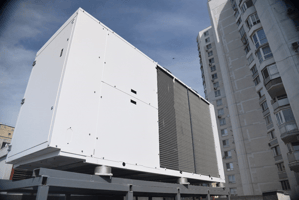HVAC/R equipment plays a significant role in the environmental landscape, with both positive and...
Unlocking the Advantages of Lighter Weight Small-Diameter Tubes
Among the motivations driving new product design, the demand for more efficient and sustainable heating and cooling solutions increases, and the prominence of smaller copper tubes continues to grow, making them an integral component in the modern HVAC/R industry.
Copper tubes have solidified their position as a cornerstone in the HVAC/R industry. With their versatility and reliability, these tubes have emerged as a preferred choice for equipment manufacturers. They exhibit a wide range of applications and capacities ranging in diameter from 9.5 mm to predominantly 7 mm. Using copper tubes in heat exchanger applications is driven by their exceptional heat transfer capabilities, durability, and overall efficiency. The migration from larger copper tubes to smaller diameters, such as 5 mm and enhanced (inner-grooved) copper tubes, has become a game changer as equipment manufacturers look toward the future.
For over a decade, in China, Japan, and South Korea, the standard for residential AC appliances has been using 5 mm diameter copper tubes. These countries have widely embraced the benefits of smaller diameter tubes, which provide efficient heat transfer, compact design options, and optimized energy consumption. The consistent usage of 5 mm diameter copper tubes highlights the reliability and success of this choice in these countries' residential air conditioning sectors.
Smaller Diameters - The Key to Efficiency
As copper tube specifications drive towards thinner tube walls, implementing "inner grooving" or tube enhancement techniques allows these tubes to maintain an equivalent strength level to larger diameter tubes with thicker walls. This innovation showcases copper's remarkable strength and durability, enabling manufacturers to optimize performance without sacrificing structural integrity.
The advantages of smaller diameters regarding efficiency, heat transfer capabilities, and energy consumption are far-reaching. One of the significant benefits is improved energy efficiency, as smaller-diameter copper tubes allow for more effective heat exchange, resulting in optimized system performance.
Additionally, the utilization of smaller tube diameters results in a decrease in the consumption of tube materials, fin materials, and refrigerants, ultimately reducing the overall cost of the system.
Small-diameter copper tubes offer the additional advantage of significantly reducing refrigerant volume. This reduction is due to the smaller internal volume of the coils, which requires less refrigerant to charge the coil. As a result, using smaller volumes of refrigerant brings additional design benefits, such as a further reduction in the system's overall weight.
Moreover, the familiarity of smaller-diameter copper tubes in the industry makes them a reliable and trusted choice for a wide range of applications.
In this publication titled Less Is More: Why Smaller Diameter Copper Tubes are More Efficient, you can read more in-depth about achieving energy efficiency at a lower material cost while reducing overall system size.
Energy Efficiency and Sustainability
Utilizing smaller-diameter tubing is crucial in advancing sustainability initiatives by delivering significant benefits, including reduced energy consumption and carbon emissions. By requiring less material and energy during production, smaller-diameter tubing helps decrease the overall environmental impact. Furthermore, smaller tubing brings efficiency gains beyond manufacturing, as it lowers energy requirements in applications like fluid transport and HVAC systems. This reduction in energy consumption leads to cost savings and aligns seamlessly with global efforts to combat climate change and minimize environmental impact. Embracing smaller-diameter tubing contributes to a more sustainable future where resource efficiency and environmental consciousness are prioritized.
The Future is Small-Diameter Copper
The potential of smaller-diameter copper tubing is a catalyst for innovative design in heat exchangers. Embracing the power of reduced diameters in copper not only presents opportunities for enhanced thermal efficiency but also allows for more intricate and compact heat exchanger designs. By harnessing the advantages of smaller diameters, engineers and designers can explore creative configurations that optimize heat transfer and overall system performance. This innovation is a technical advancement and a key player in shaping a sustainable future. The inherent properties of copper, combined with the efficiency gains from smaller diameters, contribute to more sustainable heat exchange solutions. As industries strive to reduce energy consumption and environmental impact, integrating smaller-diameter copper tubing in heat exchanger designs becomes a tangible step forward in achieving technological innovation and environmental stewardship.
To learn more about policy impacts and considerations for new heat exchanger design, watch our latest webinar, Designing for New Refrigerants, presented by Cara Martin, COO of Optimized Thermal Solutions, Research and Development.
For more information on the advantages of using small-diameter copper tubes in heat exchanger design and what it means to partner with CDA and our network of experts, contact the Copper Development Association.


